Your Ultimate Guide to Getting Started With NFTs on Rarible
With this article, we want to help you explore Rarible and show you how to dive into Web3.
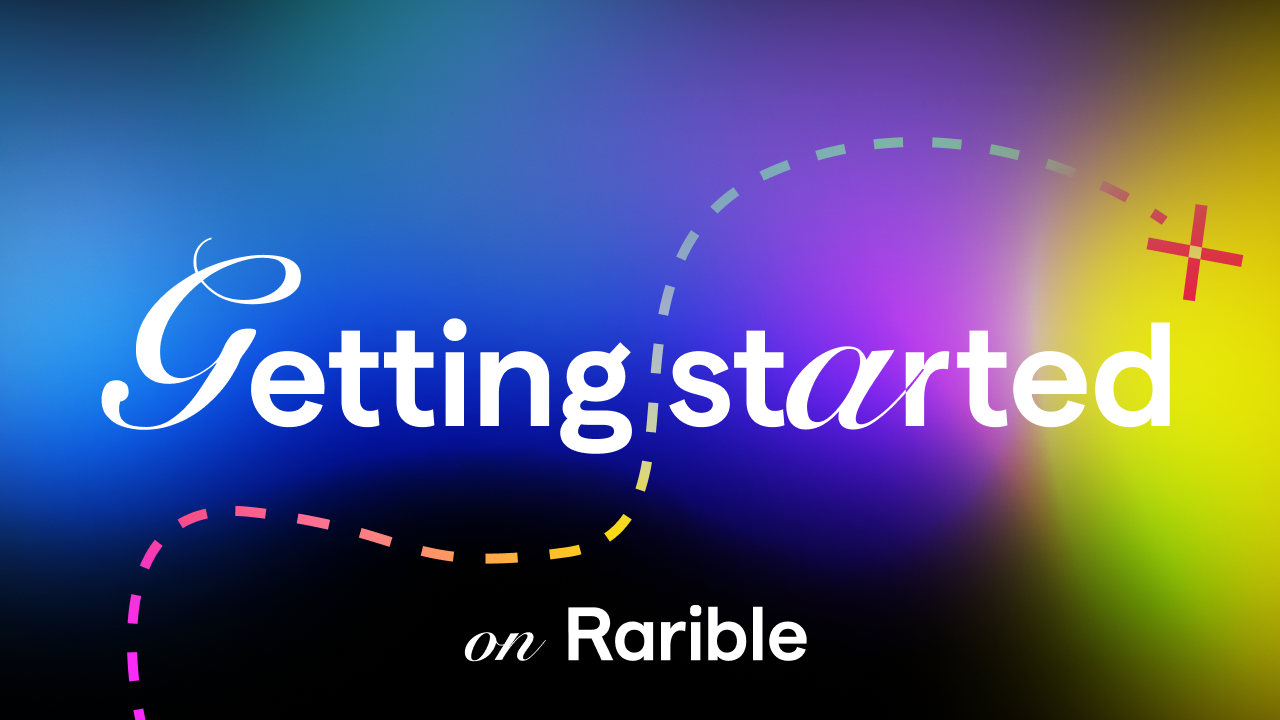
If you clicked on this article, there’s a good chance this is your first time on Rarible. It might even be your first time on anything NFT-related!
Whether you want to start a museum-level collection, become the next great NFT artist or just flip a few JPEGs for fun, you’ve come to the right place. With this article, we want to help you explore Rarible and show you how to get started.
This article is quite long, so we’ve split it up into a few parts. Click the links below to jump to the corresponding section immediately:
👉 I’ve never bought or minted an NFT and want a general introduction
👉 I want to create a crypto wallet and start collecting NFTs
👉 I don't know which blockchain to choose for my NFTs
👉 I have an NFT and want to sell it
Or just keep reading and explore it all!
WTF are NFTs and Web3?
If you’ve never bought or sold an NFT, the space can be confusing. Everybody has strong opinions, the language is obscure and WHAT THE HECK MAKES A CARTOON MONKEY WORTH $100K?!
This part of the article will simplify the space for you. Here’s a basic explanation of NFTs and Web3.
Most explanations start by explaining that NFT stands for non-fungible token. But that raises more questions than it answers. It replaces a confusing abbreviation with three confusing words. Double confusion!
Let’s replace that confusion with clarity. An NFT is basically a digital certificate of authenticity (COA). If you buy a rare pokemon card, genuine Banksy art or a luxury watch, you get a COA. Why? Because these things are so valuable that fraudsters create fake versions.
Without the COA, selling these things for their real value is harder, even when you have an authentic item.
While a knock-off looks the same (anybody can print out the Mona Lisa), there’s something unique about having the original. Even if you had a perfect fake Rolex that made everyone jealous, you wouldn’t feel the same as if you had a real one.
For valuable physical items, we basically ask: “Does the person/company who makes these items approve of this specific item?”
This type of authentication is harder for digital things. If an artist paints a beautiful landscape on their iPad and shares it on Twitter, Instagram and Behance—which one is the original? If a DJ produces a techno track and publishes it to Bandcamp, YouTube and Soundcloud—which one is the original?
Before NFTs, it was impossible to say. Blockchains (the background technology for NFTs) allow anyone to issue a certificate of authenticity for their work—and sell it. That might sound like a nice thing for creators. But to get back to our introductory question: WHAT THE HECK MAKES A CARTOON MONKEY WORTH $100K?!

While NFTs are awesome for artists, they enable something even more powerful: Community.
Imagine you had an authentic piece of Andy Warhol artwork. It's cool for you and your friends. But imagine if there was a group of Warhol owners who met up every week. Your entry ticket: The COA for your Warhol.
There's a good chance you'd check out the event. After all, you'll probably meet awesome people who share your taste in art, culture and values. By meeting those people, you might make friends, grow your business network and discover new artists you enjoy.
These events are hard to organize for physical Warhols (or I don't get invited 😢): How do you get all these people in the same place? How do you verify their COA is authentic?
NFTs simplify that. Anyone can verify which NFTs a certain wallet holds. And the internet removes the necessity to meet up physically.
That's why many NFTs are about community more than art. By buying a Bored Ape Yacht Club NFT, you get more than a picture of a monkey: You get access to an exclusive community. That's why two social media platforms are essential for NFT culture:
- Twitter is the home for public NFT conversations and discovery. The company itself leans into that by verifying NFTs: Whenever you see somebody's profile picture (PFP) in a hexagon, it's an NFT.
- The exclusive communities usually exist in Discord, a platform for online communities of all types.
To get started, just follow Rarible on Twitter and join our Discord.
We often partner with other projects and share resources to learn more, so you'll discover more projects and communities as time goes on.
But while these communities are often awesome, fun and supportive, you'll feel lost without understanding some of the terms. Here are a few you'll probably encounter soon:
Web3 Culture 101:
gm: Stands for good morning, but is generally used as a greeting any time of the day.
gn: Stands for good night, but is generally used to sign off at any time.
gmi: gmi stands for "gonna make it". If you share something awesome, people might tell you you're gmi.
wagmi/wgmi: We're all gonna make it. This expresses optimism for the entire NFT space or an entire community.
ngmi: "not gonna make it". When people are pessimistic about a project, person or company, they'll often say ngmi.
Web3: Web3 is the next generation of the internet. Instead of giant corporations owning most online content, Web3 describes an internet where you own your data and your digital assets and can trade them with others. Consequently, it involves everything crypto and NFT-related.
If Web3 sounds awesome, then you probably can't wait to get started. So let's dive into how to use/create NFTs!
How to make/own NFTs
As we've explained before, an NFT is like a certificate of authenticity. But a COA always refers to something else. With NFTs, that something else could be anything. You can attach any file to one. Images have been most popular, but your NFT could also link to a video, music or piece of writing. Alfa Romeo is even attaching NFTs to its new cars to help store maintenance records.
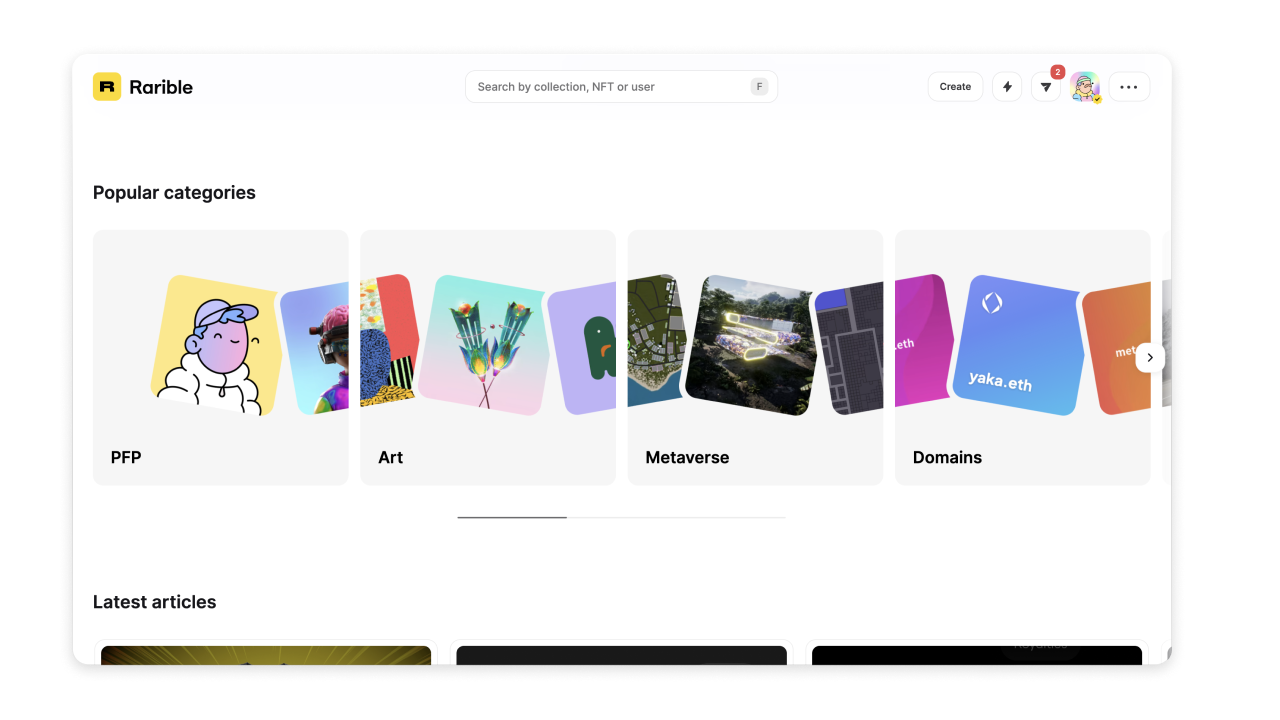
But NFTs go through phases. By the time you read this article, there might be completely new use cases for NFTs. That's why it’s so important to understand that anything can be an NFT.
So yes, while most people think of images when they think of NFTs, you could buy or sell anything as an NFT.
But let’s assume you have a piece of art you want to buy or sell as an NFT. To hold or create NFTs, you need a cryptocurrency wallet for a blockchain Rarible supports. We’ll discuss different blockchains in more detail below.
Here’s how to create a crypto wallet:
When you install a wallet browser extension or crypto wallet app, you get a “seed phrase” — a series of words which let you recover your currencies or NFTs if you lose access.
NEVER GIVE THIS PHRASE TO ANYONE. Anyone who knows your seed phrase has full access to your wallet and can buy, sell or transfer any funds or assets. Neither Rarible support nor any trustworthy individual or organization will ever ask for your seed phrase. We also strongly suggest not to store your seedphrase on a device connected to the internet (as a .txt file or a saved message). Instead, you can write it down on a piece of paper, and/or memorize it —just make sure you have access to it at any time.
To transact with cryptocurrencies or NFTs on Rarible or anywhere else, you need to connect your wallet to log in.
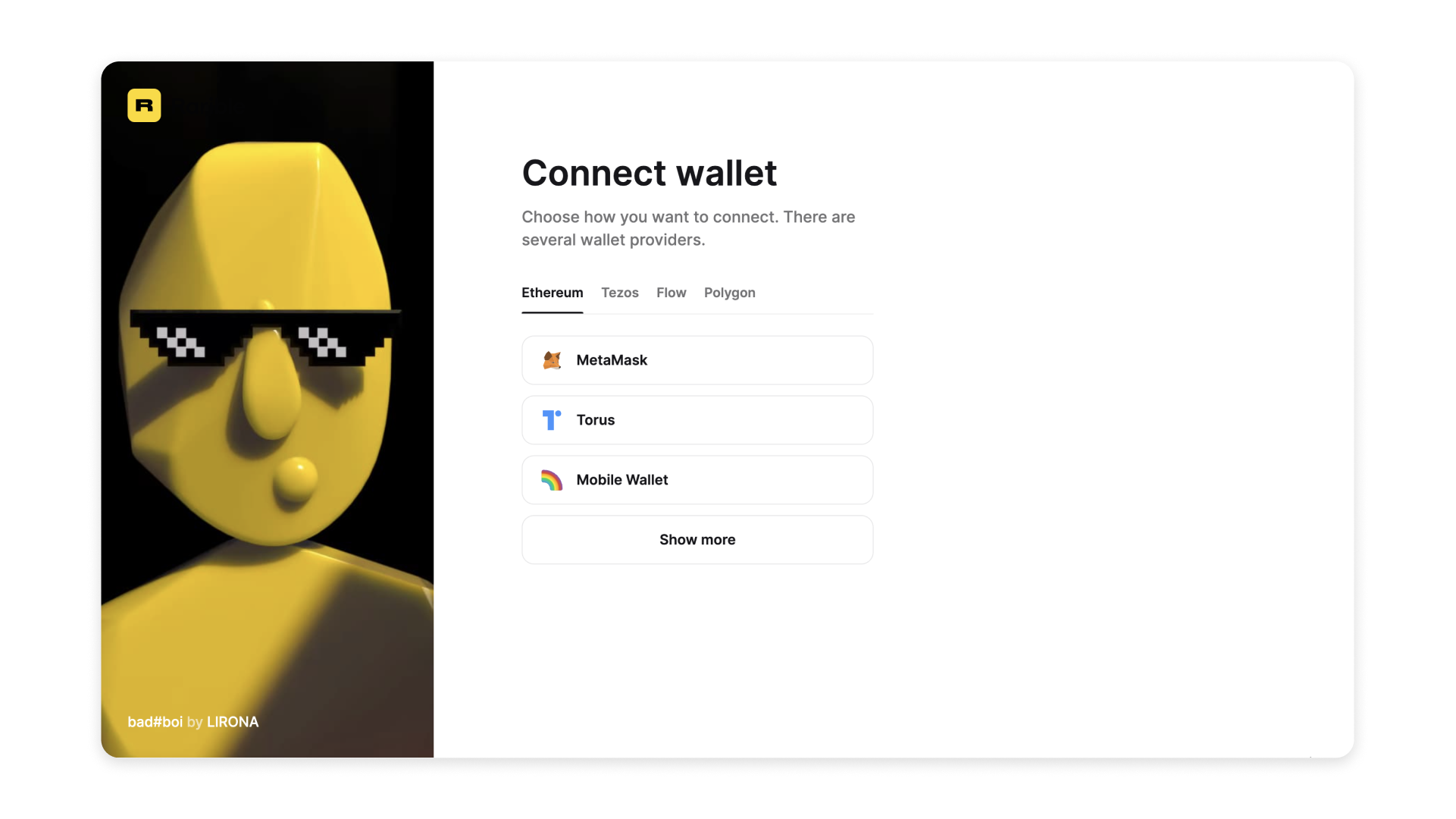
Some of the wallet connect options on Rarible include MetaMask, Rainbow, Coinbase, Temple, Blocto, Portis, Trust and others.
(Note: As soon as you’ve got some assets, it makes sense to get a hardware wallet. These are the safest options to store crypto and NFTs. You don’t need one to get started, but we highly recommend hardware wallets once you’ve bought/minted your first NFTs)
But before you create your first NFT, you need to choose which blockchain you want to use.
Choosing the right blockchain
Blockchains are the networks NFTs exist on.

You can imagine it like choosing a country to start your business in. Which one you choose determines the community you’ll reach, the currency you get paid in, the taxes you pay and the competitors you have.
If you’re buying NFTs, you don’t have a choice—the NFT is minted on the chain it’s minted on. So you have to use whatever blockchain your desired NFT is minted on.
Rarible currently supports four different blockchains, but we'll be adding even more as we grow. Here’s each blockchain with its pros and cons:
- Ethereum is the most popular blockchain for NFTs. It’s reliable, secure and has the biggest community. Because of its popularity, it also has the highest fees and energy consumption of any blockchain on Rarible (although you can offset the carbon for most Ethereum NFTs on our platform). Ethereum has the most eclectic mix of NFTs, from profile pictures to individual artists.
- Tezos is the most popular chain for smaller, independent artists. Its low fees and high performance attracted a vibrant scene of collectors and creators from all sorts of cultures, styles and media.
- Flow is best-known for hosting collectibles for major sports organizations. Its fees are a fraction of a penny, which makes it accessible to anyone.
- Polygon is essentially an extension of Ethereum. It inherits much of Ethereum’s advantages, but has much lower fees. It mostly houses gaming projects.
- Solana is Ethereum’s closest rival. It’s a fast-growing blockchain which houses many cool profile picture (PFP) and other projects. Transaction fees are less than one cent and new purchases settle quickly
The best guideline is to use a blockchain you can afford and that your community is already familiar with.
Minting your first NFT
If you’re an artist and want to turn your art into NFTs, this section is for you. If you want to start buying NFTs, feel free to head to the next section.
Creating an NFT is called “minting”. To mint, sign in to Rarible using your wallet. If it’s your first time doing anything with a crypto wallet, signing up will be a bit unfamiliar. You don’t need to set a password or add your email address (although you can enter your email on Rarible once you log in to receive updates on your NFTs). You only need to connect your wallet.
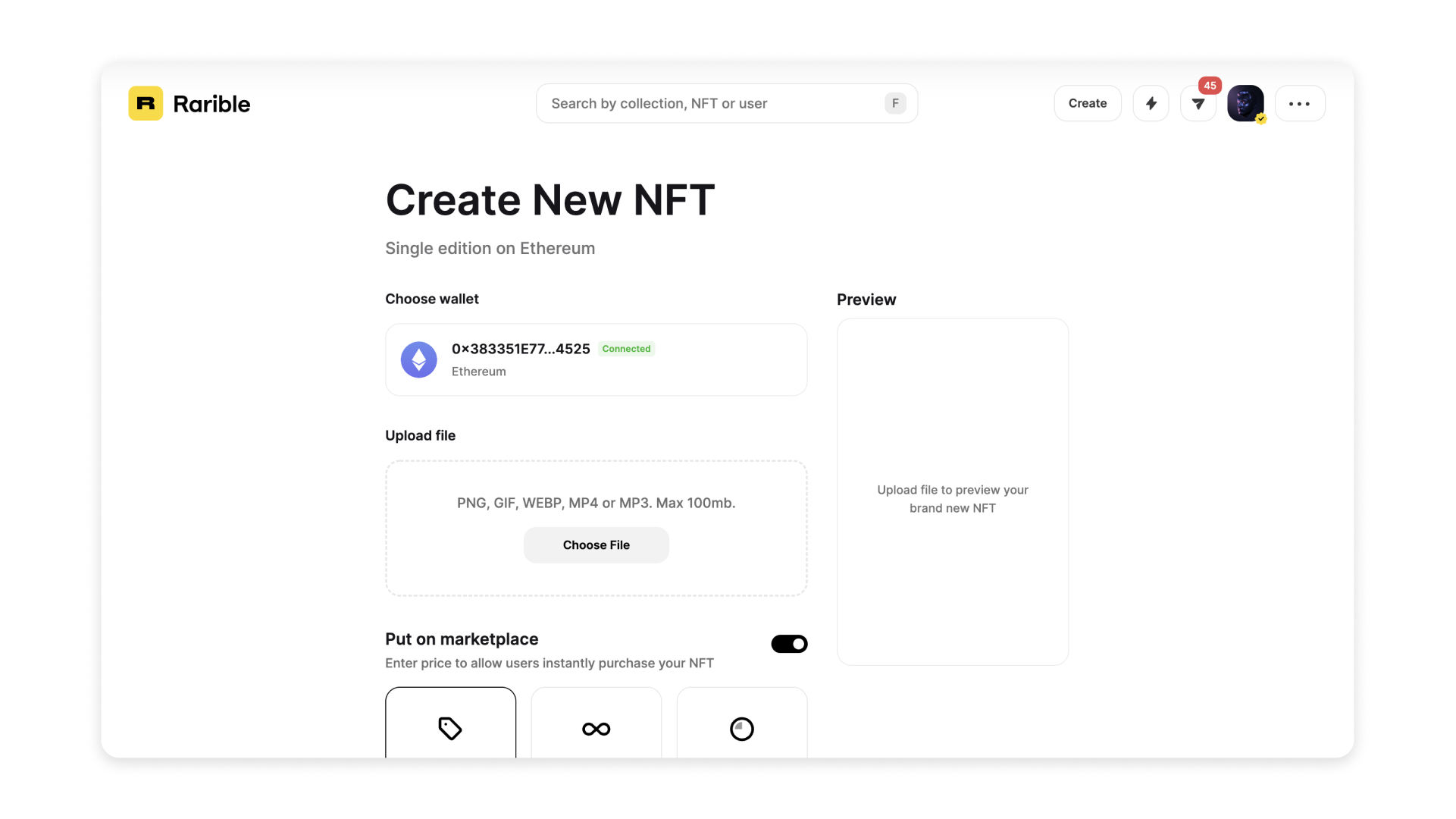
After that, click create and select the blockchain your wallet is on. After that, you can choose whether you want to create a 1/1 artwork or a series of multiple.
That’s like the difference between making one bespoke painting or a print series of multiple. If you choose single, only one person can buy this piece of art. That means the piece will feel more special to its owner. But it also limits your potential buyers to 1. If you create a series, more people can buy your work and share it.
Before we get into minting your work on the blockchain, one important note: Only ever mint (and sell) artwork by yourself (or that you can legally use). We remove NFTs that violate copyright law.
After making your choice, you’ll see the final minting screen. This is where you upload your work, choose a price and decide how you want to sell it. After setting everything up, hit “create item” and confirm in your wallet.
(Note: One thing that might be confusing is the “royalties” section. Here, you can choose a percentage of each resale you want to be paid. So if your artwork sells between your fans, you’ll get a percentage of that every time.)
On most chains, you’ll have to pay a “gas fee”—a transaction fee on the blockchain’s network. This could range from a few cents to dozens of dollars. This might require you to fund your wallet with some tokens.
There are two main ways to do this:
- Buy crypto on an exchange and send it to your wallet. Make sure you buy the right coin on the right wallet.
- Many wallet providers let you top up your wallet with a credit card.
If you don’t want to pay transaction fees, you can “lazy mint” on Ethereum. When you do this, you won’t pay any fees to mint your NFT. But a word of caution: Your first buyer will pay a higher fee for lazy-minted NFTs. So once you’ve built up your community, it’ll be much easier to sell your NFTs if you’ve paid the fee up front. Here's how to lazy mint:
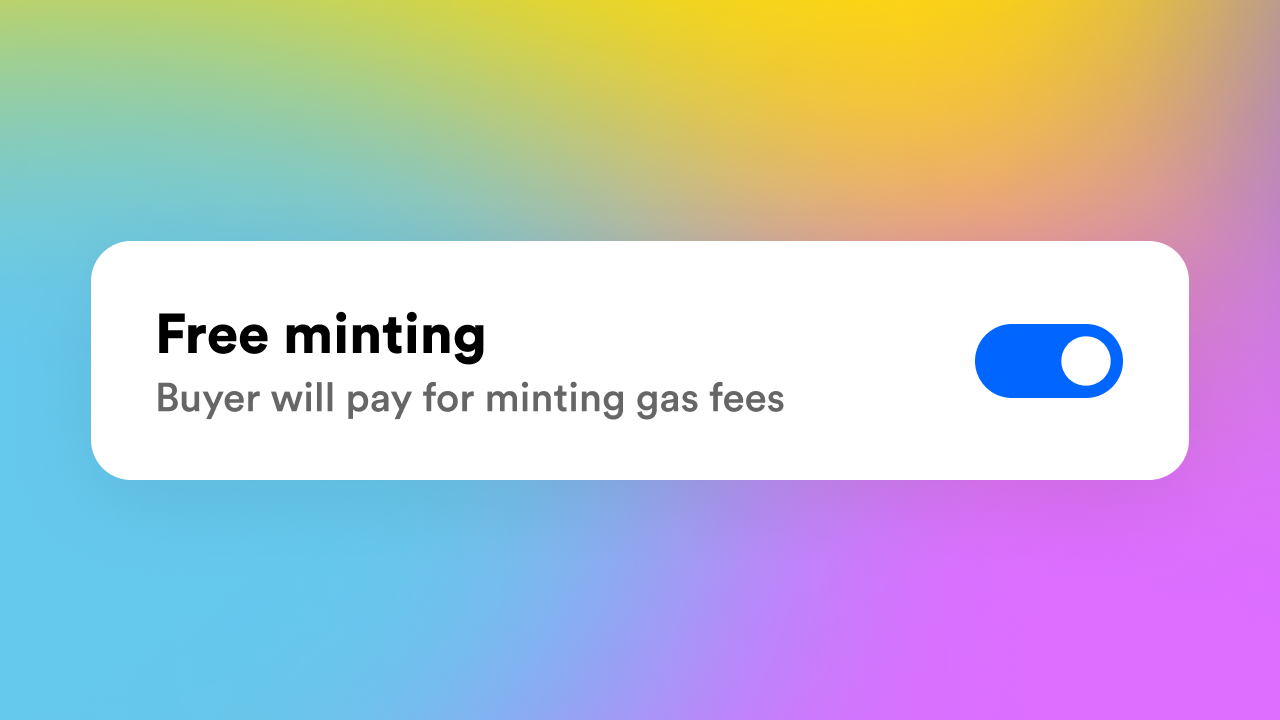
And ta-da! You’ve just minted your first NFT! We’ll cover how to put it on sale in a little bit.
Creating your own collection
NFT collections are like folders for NFTs. By default, minting on Rarible will put your NFT in the Rarible collection. It’ll still list you as a creator, but put it under a Rarible umbrella.
You can also create your own collection. That makes it easier for your community to find your work and buy it. But creating your own collection also costs additional gas fees once. We generally recommend minting under the Rarible collection first and starting your own collection once you’ve sold a few NFTs.
Buying your first NFT
If you’ve found an NFT community you want to join or know an artist you want to support, here’s how to buy your first NFT: Sign in to Rarible with your wallet.
After you’ve connected your wallet, find the NFT you want to buy. If you’re buying from a bigger collection, look for the yellow checkmark, which verifies users and collections. That means it’s the real deal.
Unfortunately, bad actors create collections and profiles that look like well-known NFT projects or artists, but aren’t from the original creators. Always make sure you’re buying from the actual creator by double checking links/NFT contract address.
It’s just like a COA for physical art: Anyone can print one out—it has to be from the original artist to count.
But once you’ve verified the NFT you want to buy, click “buy” at the bottom of the page. If you have enough funds in your wallet, click confirm and and approve the purchase in your wallet.
After the blockchain confirms your transaction (30-60 seconds usually), your NFT is safely stored in your wallet!
How to sell an NFT on Rarible
When you’re ready to part with an NFT (or want to put your own art on sale), you can list it for sale. Head to your profile, click on the NFT you want to sell and click on “put on sale”.
You can do that in three ways:
Fixed price: Set a price for your item and wait for someone to buy it.
Open for bids: People can make you an offer for your NFT. Accept whichever sounds fair to you.
Timed auction: Start an auction and let people bid. At the end of the timed auction, the highest bidder gets your NFT in exchange for what they bid on it.
Are NFTs sustainable?
Lots of folks criticize NFTs for being unsustainable because the associated transactions consume too much energy.
While they have great intentions, these allegations are often a bit extreme. While proof of work cryptocurrency mining does consume a lot of energy, the only blockchain on Rarible still on proof of work is Ethereum, which itself is switching to the much more energy-efficient proof of stake mechanism, which promises to lower its energy consumption by 99.5% in the near future.
Proof of stake blockchains generally consume little energy: Across 50 million transactions, Tezos only consumed the equivalent of 17 global citizens last year.
But we don’t stop there: Every Ethereum NFT has a button that says “remove carbon”. For a small fee, you can pay for carbon removal with our partner Nori for the amount of emissions your NFT has likely caused.
After you get your first NFT: Here’s how to connect with others
To find fellow NFT enthusiasts, you can jump on Twitter, join Discords or use Rarible Messenger. Search for the project you just bought into on Twitter, join the official Discord or engage with the community by sending Rarible Messenger DMs. The latter option allows you to message any wallet address—just click on the paper plane icon at the top right to get started.

The most important part is making the first move. Once you start engaging with NFTs and meeting friends, you’ll be unstoppable!
Wrapping up: Get started today
NFTs can seem like a lot. Even if you go step by step, get started today. As we said before, whatever you want to get out of NFTs, you’ll only get it if you take the first step and start learning in the process. Just make sure not to spend more than you can’t afford to lose, and remember that this space is still very young and volatile.
And if you need help, join our Discord and reach out to someone in the Rarible fam!
Meanwhile, if you want to dive deeper, make sure to explore these articles:


